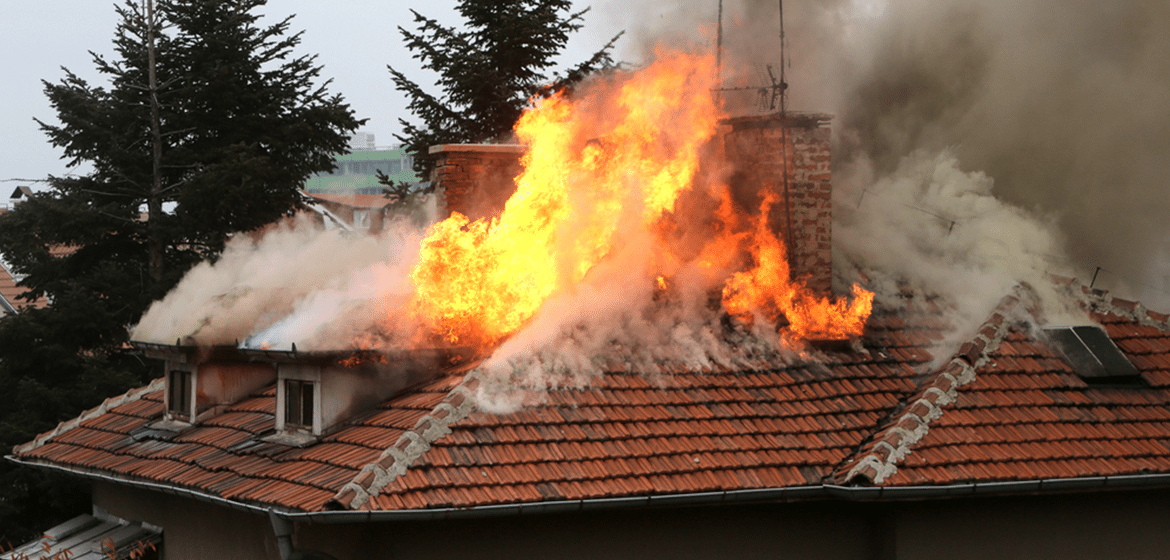
Roof fires can be devastating, leading to extensive property damage and endangering lives. Understanding the common causes of roof fire hazards is crucial in preventing such incidents. This comprehensive guide will explore various factors that contribute to roof fires and provide practical tips for reducing these risks.
Electrical Issues
Electrical problems are one of the primary causes of roof fires. Faulty wiring, overloaded circuits, and damaged electrical components can generate sparks that ignite roofing materials.
- Old Wiring and Poor Installation
Homes with outdated electrical systems are particularly vulnerable. As wiring ages, its insulation can degrade, increasing the risk of short circuits and overheating. Poor installation practices, such as using improper connectors or leaving wires exposed, can also lead to dangerous conditions. Regular roof inspections can help identify potential electrical issues before they escalate. - Overloaded Circuits
Overloading circuits by plugging in too many devices can cause excessive heat buildup. This heat can transfer to the roof structure, igniting flammable materials. It’s essential to ensure your home’s electrical system is appropriately rated for its current load and to avoid overloading circuits.
Chimneys and Fireplaces
Chimneys and fireplaces, while adding warmth and ambiance to a home, can also pose significant fire hazards if not properly maintained.
- Creosote Buildup
Creosote, a byproduct of burning wood, can accumulate in the chimney over time. This substance is highly flammable and can ignite if it builds up in sufficient quantities. Regular cleaning of chimneys is essential to prevent creosote-related roof fires. - Sparks and Embers
Sparks and embers from fireplaces can escape through the chimney and land on the roof, especially if the chimney lacks a proper spark arrestor. Ensuring that chimneys are equipped with these devices can significantly reduce the risk of roof fires caused by stray embers.
Flammable Roofing Materials
The type of roofing materials used on your home can influence its susceptibility to fire.
- Wood Shingles and Shakes
Wood shingles and shakes, while aesthetically pleasing, are highly flammable. In areas prone to wildfires or frequent lightning strikes, these materials can easily ignite. Opting for fire-resistant alternatives, such as asphalt shingles or metal roofing, can enhance your home’s safety. - Inadequate Fire Retardants
Some roofing materials are treated with fire retardants to enhance their resistance. Over time, these treatments can wear off, reducing the roof’s ability to withstand fire. Regular roof maintenance and inspections can ensure that fire retardant treatments are reapplied as needed.
External Fire Sources
Fires originating outside the home can also pose significant threats to the roof.
- Wildfires
In regions prone to wildfires, homes with flammable roofing materials are at increased risk. Windborne embers can travel considerable distances, igniting roofs even if the primary fire is miles away. Using fire-resistant roofing materials and maintaining a defensible space around the home can mitigate this risk. - Lightning Strikes
Lightning strikes can generate intense heat, capable of igniting roofing materials instantly. Installing a lightning protection system can help divert electrical energy away from the roof, reducing the likelihood of fire.
HVAC Systems and Ventilation
Heating, ventilation, and air conditioning (HVAC) systems can also be sources of roof fires if not properly maintained.
- Faulty Equipment
HVAC systems involve electrical components and can develop faults over time. Malfunctioning equipment can overheat, potentially igniting surrounding materials. Regular maintenance of HVAC systems is crucial in preventing these issues. - Blocked Vents
Vents are essential for allowing heat and fumes to escape from the home. If vents become blocked by debris or pests, heat can accumulate, leading to dangerous conditions. Ensuring that vents are clear and functional can prevent fire hazards.
Human Activities
Certain human activities can inadvertently lead to roof fires.
- Improper Use of Fireworks
Fireworks are a common cause of roof fires, especially during festive seasons. Misfired or improperly used fireworks can land on roofs, igniting flammable materials. It is important to use fireworks responsibly and keep them away from residential areas. - Barbecues and Grills
Barbecues and grills used near the house can pose a risk if not properly monitored. Hot embers or grease fires can easily spread to the roof. Always use grills at a safe distance from the home and never leave them unattended.
Poorly Maintained Roofs
Neglecting regular roof maintenance can significantly increase the risk of roof fires. Debris such as leaves, branches, and other organic materials can accumulate on the roof, providing fuel for a fire.
Debris Accumulation
Leaves, pine needles, and other debris that gather in roof valleys and gutters can dry out and become highly flammable. In dry conditions, a small spark from a nearby fire or an electrical fault can ignite this material. Regular cleaning of roofs and gutters is essential to prevent debris buildup.
Damaged Roofing Materials
Damaged or missing shingles can expose the underlying materials to weather elements, which can deteriorate and become more flammable over time. Regular roof inspections and timely repairs can help maintain the integrity of the roof and reduce fire risk.
Nearby Vegetation
Vegetation growing too close to the roof can be a significant fire hazard. Overhanging branches and nearby trees can catch fire and spread flames to the roof.
Tree Branches and Shrubs
Tree branches that extend over the roof can drop leaves and twigs, which can accumulate and become a fire risk. In addition, in the event of a fire, these branches can act as a direct conduit for flames to reach the roof. Trimming back overhanging branches and maintaining a safe distance between vegetation and the roof can mitigate this risk.
Climbing Plants
Climbing plants such as ivy can grow over the roof and walls, trapping moisture and creating conditions that can lead to decay and increased flammability. Removing climbing plants from the roof and walls can help prevent these issues.
Roofing Installation and Materials
The method and materials used in roof installation can also affect the risk of roof fires. Proper installation and the use of fire-resistant materials can significantly reduce this risk.
Professional Installation
Hiring professional and experienced roofing contractors ensures that the roof is installed correctly, with proper ventilation and the use of fire-resistant materials. Poor installation practices can create vulnerabilities that increase the risk of fire.
Fire-Resistant Materials
Opting for fire-resistant roofing materials, such as Class A shingles, metal roofing, or tile, can provide an additional layer of protection against fire. These materials are designed to withstand higher temperatures and are less likely to ignite.
Preventing Roof Fire Hazards
Understanding and addressing the common causes of roof fire hazards can significantly reduce the risk of devastating roof fires. By maintaining electrical systems, cleaning chimneys, using fire-resistant materials, and ensuring proper roof maintenance, homeowners can protect their property and ensure the safety of their families.
Regular roof inspections and proactive maintenance are crucial in identifying and mitigating potential fire hazards.
If you need a reliable roofing contractor to help inspect and maintain your roof, contact us at Dane Roofing. Our experienced team is dedicated to providing the highest quality roofing services to ensure your home is safe from roof fire hazards. Reach out to us today to schedule a roof inspection or consultation. Let us help you protect your home with our top-notch roofing solutions.

